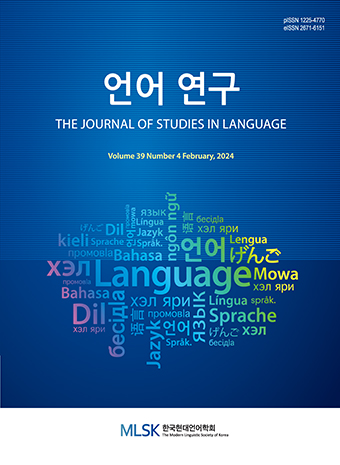Research Article
Abstract
References
Information
Previous studies of –to in Korean have assumed a certain degree of parallelism between the Korean particle and too in English. This paper presents a set of cases involving –to in Korean, which stands in clear contrast with the usage of too in English. Following Kripke’s observation that too in English requires an antecedent in active contexts, Geurts and van der Sandt and others treat it as an anaphoric presupposition trigger and relate the anaphoricity of the particle with its inability to accommodate its presupposition. In this paper, it is shown that –to in Korean cannot be handled by an anaphoric approach because it can either have antecedents in non-active contexts, or no antecedent at all. This paper proposes a non-anaphoric analysis of –to in Korean, and it is argued that the lack of anaphoricity of –to allows it to accommodate its presupposition easily, unlike too in English.
- Beaver, D. and H. Zeevat. 2007. Accommodation. In G. Ramchand and C. Reiss (eds.), The Oxford Handbook of Linguistic Interfaces. Oxford University Press, 503-538.10.1093/oxfordhb/9780199247455.013.0017
- Chafe, W. 1976. Givenness, Contrastiveness, Definiteness, Subjects, Topics and Points of View. In C. Li and S. A. Thompson (eds.), Subject and Topic. New York: Academic Press. 25-55.
- Carston, R. 2002. Thoughts and Utterances. Oxford: Blackwell.10.1002/9780470754603 11964277
- Dryer, M. 1996. Focus, Pragmatic Presupposition, and Activated Propositions. Journal of Pragmatics 26, 475-523.10.1016/0378-2166(95)00059-3
- Heim, I. 1992. Presupposition Projection and the Semantics of Attitude Verbs. Journal of Semantics 9, 183-221.10.1093/jos/9.3.183
- Kim, C. 2016. The Secondary Meaning of Korean Focus Marker Man ‘Only’ and To ‘Too/Also’: A Presupposition or a Conventional Implicature? Studies in Linguistics 41, 135-155.10.17002/sil..41.201610.135
- Kim, Y. 1999 Semantic and Pragmatic Aspects of the Delimiter To. Language and Information 3.2, 85-96.
- König, E. 1991. The Meaning of Focus Particles: A Comparative Perspective. London: New York: Routledge.
- Kripke, S. 2009. Presupposition and Anaphora: Remarks on the Formulation of the Projection Problem. Linguistic Inquiry 40.3, 367-386.10.1162/ling.2009.40.3.367
- Lee, Y. 2004. The Syntax and Semantics of Focus Particles. Ph. D. Dissertation. MIT.
- Lewis, D. 1979. Scorekeeping in a Language Game. Journal of Philosophical Logic 8. 339-359.10.1007/BF00258436
- Potts, C. 2005. The Logic of Conventional Implicatures. Oxford University Press.10.1093/acprof:oso/9780199273829.001.0001
- Prince, E. 1981. Toward a Taxonomy of Given-New Information. In P. Cole (ed.), Radical Pragmatics. New York: Academic Press. 223-254.
- Simons, M. 2003. Presupposition and Accommodation: Understanding the Stalnakerian Picture. Philosphical Studies 112, 251-278.10.1023/A:1023004203043
- Sperber, D. and D. Wilson. 1986. Relevance: Communication and Cognition. Oxford: Blackwell.
- Publisher :The Modern Linguistic Society of Korea
- Publisher(Ko) :한국현대언어학회
- Journal Title :The Journal of Studies in Language
- Journal Title(Ko) :언어연구
- Volume : 35
- No :1
- Pages :109-120
- DOI :https://doi.org/10.18627/jslg.35.1.201905.109




 The Journal of Studies in Language
The Journal of Studies in Language






